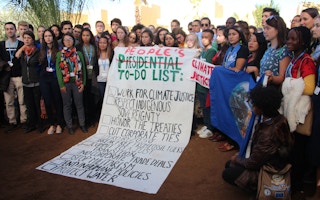Last year brought major political shocks to the world: the election of Donald Trump; the rise of “fake news”; and the emergence of populist, anti-globalisation movements in Britain, the Philippines and elsewhere. Many of these were fuelled by the growing feeling among certain groups that they are being left out of economic opportunities.
The big question for 2017 is: Are these disruptions merely a speed bump for progress toward a more sustainable, equitable world, or will they signal a much larger retreat?
WRI president and CEO Andrew Steer addressed this question today in Washington at the Institute’s annual Stories to Watch presentation, highlighting six major topics to scrutinise over the course of this year. How they unfold will help determine whether we continue to curb emissions, expand the economy and foster sustainable development – or not.
Story #1: How far will Trump go?
In advance of his inauguration as US president on January 20, president-elect Trump has named several climate sceptics to his cabinet. It will be important to watch how these new leaders and their policy decisions affect environmental protections, such as ozone and methane emissions standards, renewable energy fuel and energy efficiency standards and the clean water rule.
The role of the United States as a climate leader is also at stake, with an uncertain future for the Clean Power Plan, US commitment to the Paris Agreement on climate change, and the country’s ability to meet its national target to reduce emissions 26 to 28 per cent by 2025.
“There’s nothing particularly partisan about protecting God’s creation — traditionally it’s been the Republicans who have often led,” Steer said. “So let’s not assume before we see real evidence, but there’s no question the statements (by Trump) suggest there will be a gutting of some of the environmental protections in this country.”
It will be interesting to watch how leaders at the local levels respond. Already, 15 states and 51 cities have called for climate action. In the face of threats at the federal level, will these leaders, those in Congress and citizens step up their game?
Story #2: Fossil fuel renaissance vs. renewable energy surge
Although Trump has promised to bring back coal, he is unlikely to be able to do so given current economic conditions.
The US coal industry has slumped since 2008, and clean energy is now one of the fastest-growing US job sectors. Wind and solar power are now nearly cost-competitive with coal and natural gas in many areas. “Coal declining in the United States has almost nothing to do with climate legislation at all,” Steer said. “It has to do with pure economics.”
And globally, while one-third of planned power capacity is still in coal, renewable energy investment was double that of coal and gas last year. Will this growth continue? Follow-through on renewable energy commitments from big players like India and China will be strong indications, as well as financial outcomes from July’s G20 Summit.
Story #3: Will international momentum on climate action continue?
Last year was a landmark moment for international climate action when 196 countries adopted the Paris Agreement. The only three that haven’t signed are Syria, Uzbekistan and Nicaragua.
Many countries are already translating their Paris commitments into action on the ground. For example, 38 nations and eight institutions have joined the NDC Partnership, which aims to accelerate action and raise ambition on implementation of national climate goals.
It will be important to watch whether more progress is made in the coming year. Some important moments include: Will India hit its ambitious solar targets? Will China successfully roll out a national carbon market? And, will the new UN secretary-general Antonio Guterres make climate change as high a priority as his predecessor Ban Ki-moon did?
Story #4: Tomorrow’s markets
Many businesses aren’t just moving toward sustainability; they’re leading on it. More than 200 companies have committed to set emissions-reduction targets based on what the science says is necessary to prevent the worst effects of climate change, nearly 600 are working toward deforestation-free supply chains, and 84 have committed to source 100 per cent renewable energy.
At the same time, investors are increasingly managing funds using environmental, social and governance factors (ESG), and mounting evidence shows that incorporating these screens can have a neutral or even positive effect on returns. “In the old days, the picture image was governments set regulations and the private sector says ‘OK, we’ll fulfil them,’” Steer said. “Today the private sector is really driving the agenda.”
The question is whether that momentum will continue in 2017, and will the shift to sustainable investing translate into pressure in C-suites and board rooms?
Benchmarks to watch include whether more companies set science-based targets, and if these targets expand to other sectors like land and water use. It will be also interesting to see how businesses and investors respond to the forthcoming Business Commission on Sustainable Development report, due out during next week’s World Economic Forum in Davos.
Story #5: The ascent of plant-based foods
The consumption of meat and especially beef has one of the biggest impacts on the environment of any sector. Cattle are the single-largest drivers of deforestation and, if all the cattle in the world were their own country, it would be the third-largest emitter. The challenge is to curb this impact while producing the 70 per cent more food needed to feed a growing population by 2050.
Fortunately, we are seeing increasing interest in plant-based protein, especially in the United States. One-quarter of Americans already report eating less red meat, while one in 10 millennials are vegetarian or vegan. Tyson launched a venture capital fund worth $150 million to explore meat alternatives. As part of the Farm Animal Investment Risk & Return initiative, 42 institutional investors representing $1.25 trillion in assets pressured food companies to future-proof their supply chains by diversifying their protein sources. And Beyond Meat products, including plant-based proteins that taste like burgers, chicken and meatballs, are now sold in 11,000 stores.
The question is whether beef producers will begin to diversify and put in place strategies to reduce their impact? And will consumer demand for plant-based proteins and other sustainable alternatives grow?
“
The big question for 2017 is: Are these disruptions merely a speed bump for progress toward a more sustainable, equitable world, or will they signal a much larger retreat?
Story #6: Will innovation in automobiles help people and the planet?
Forget the horseless carriage. The new auto trend is driverless cars. More than 30 major companies are currently experimenting with automated vehicles. Meanwhile, ride-sharing services like Uber and China’s Didi are worth tens of billions of dollars, and there are more than one million electric vehicles on the roads globally.
The question is whether these three trends — automation, ride-sharing and electrification — will be integrated to reduce cars’ impact on the environment, or whether they’ll operate in silos and increase the number of vehicles on the road?
As WRI Board member and Zipcar co-founder Robin Chase said, “Simply eliminating drivers from cars, and keeping everything else about our system the same, would be a disaster.” After all, under the current car-centric model, workers lose about eight days a year in productivity sitting in traffic, and transportation is responsible for 14 per cent of global emissions.
It’s also important that these new innovations complement rather than compete with people- and planet-friendly mobility options like mass transit and biking.
An exciting year ahead
It may not be easy to watch how these stories play out over the next year, but 2017 certainly won’t be boring.
“Like it or not, real change will happen [this year],” Steer said. “Some changes look like they may not be very good. It’s our job to get a virtuous cycle going, and get really positive change.”
Sarah Parsons is Editor and Content Strategist at the World Resources Institute. This post is republished from the WRI blog.









